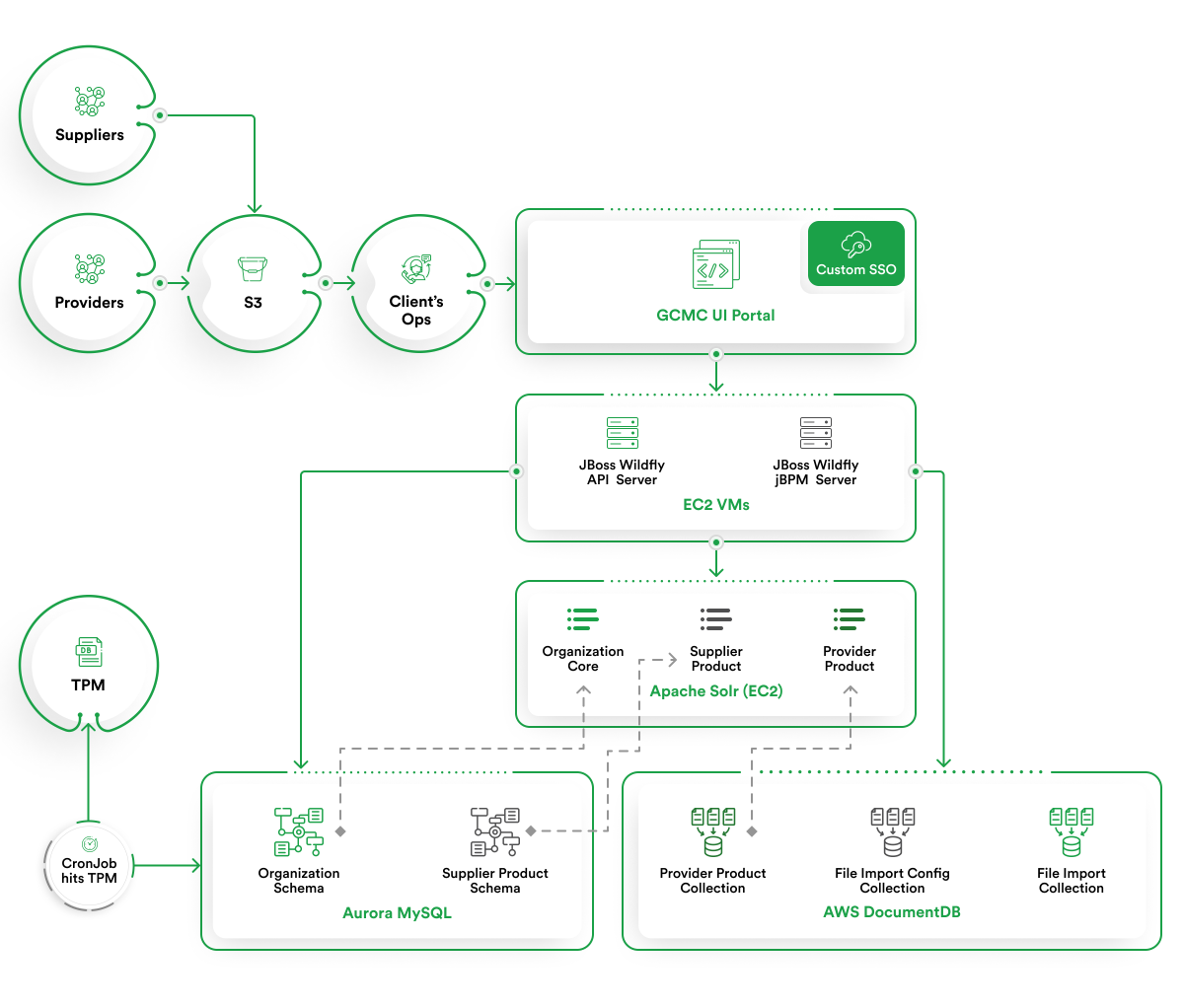
How Automation Helps Solve the Biggest Issues in Supply Chain and Delivery
Exploring how automation technology can solve the biggest challenges in supply chain, delivery and logistics.
The healthcare supply chain management market will reach $3.3 billion in the next two years. This market has been rising annually at almost 8% since the start of the COVID-19 pandemic. Key drivers of this colossal market include the increased adoption of cloud computing and other digital technologies, the need to optimize operations to survive in saturated markets, and the evolving expectations of end users.
Legacy healthcare supply chains are rife with problems, including drug shortages, poor data management, fragmented pipelines, siloed processes and databases, convoluted pricing, transport and shipping complexities, substandard interoperability, poor visibility, and weak cybersecurity postures often exploited by threat actors.
This article explores the complex world of healthcare supply chain management and highlights the importance of automation. You will also learn how to implement automation solutions for supply chains in healthcare and what challenges and obstacles you must overcome when optimizing healthcare supply chains.
The section highlights eleven critical ways that automation solutions for supply chains can benefit healthcare organizations.
Modern healthcare businesses need to be able to withstand fluctuating demands with ease. Automation can help make healthcare supply chains highly scalable so that unpredictable demands can be met without heavy expenditures or a loss of service quality.
Healthcare supply chain automation can help companies surveil and manage medical supplies and equipment deliveries. Healthcare enterprises need to follow a set of ordinances that are overseen by various federal, local, and industry-specific governing bodies. Neglecting these regulatory benchmarks by not being able to trace supplies can bring forth a barrage of challenges, ranging from heavy forfeitures to reputational damage.
Automation in healthcare supply chains can help with inventory optimization by introducing predictive analytics capabilities. Predictive analytics, by interpreting myriad patterns in and around the healthcare sector, will ensure that businesses are proactive with inventory management. Historically, many businesses often found themselves in overstock situations or lacking critical supplies in moments of need. Automated supply chains can reduce such scenarios where businesses have too few or too many supplies.
Most healthcare organizations work with many different suppliers, and this can be cumbersome without automated systems. Automation can ensure that businesses have visibility of their dealings with various vendors. It can also help them negotiate and get better results when sourcing new third-party vendors.
The healthcare supply chain, in particular, can’t afford any kind of disruptions or downtime. Incidents that challenge the resilience of organizations are inevitable. Robust supply chain management can help organizations prepare for these various incidents and disruptions by providing real-time data-driven insights and responses.
A resilient healthcare supply chain directly affects patients by ensuring that the right kinds and amounts of medicine and health-related paraphernalia are easily accessible and available when needed.
Eco-friendly initiatives are an important measure of success for healthcare enterprises. Healthcare supply chain automation can result in less waste and lower energy consumption. This is because businesses will be able to optimize supply chain routes and operations, significantly trim down resource expenditure, and avoid wastage.
Automated systems can take over more repetitive and backbreaking tasks, leaving historically overworked teams and personnel to focus on more human-centric activities. This can increase employee productivity and morale and ensure higher retention rates.
The automation of healthcare supply chains means that companies no longer have to manually identify and vet suppliers. AI-powered technologies can take into consideration many factors and criteria and provide data-driven facts that can help organizations make more informed purchasing decisions.
Modern automation solutions can continuously check for fluctuations in the quality of various supplies. These technologies can study patterns over a long period to effectively identify anomalies so that companies can begin a swift investigation and remediation process.
The demand for medical supplies can fluctuate based on several variables. Businesses need to be prepared and flexible to effectively deal with the unpredictable nature of healthcare demand. Automated supply chains leverage advanced algorithms to more accurately predict future needs, reducing the likelihood of emergency purchases at higher costs.
This section explores some key factors and scenarios that may necessitate the integration of automation into existing healthcare supply chains.
Businesses that experience large volumes of system failures that may result in delays, inefficiencies, and errors should consider phasing into a more automation-driven approach. The collective damage caused by inefficient use of resources, revenue lost to downtime, and reputational harm from disruptions can lead to the loss of competitive advantage.
AI-powered automation is often the subject of controversy. However, more and more organizations have begun to formally and meticulously find ways to integrate automation safety and responsibility. Healthcare businesses should assess the climate around automation in their region and subsector. If automation benchmarks are in place, it might be a good time to begin leveraging them.
No two organizations, even if they are in the same industry, have identical supply chain needs. Furthermore, certain organizations may have a stronger underlying awareness, infrastructure, and culture that may lend itself to a seamless transition to automated supply chain environments. Healthcare businesses need to embark on a period of self-analysis and reflection to assess whether they are ready to shift to automated systems.
Healthcare is filled to the brim with complex regulatory requirements. Regulations can range from data privacy to risk management. Neglecting these rules can result in millions of dollars in fines. Companies that have multiple complex compliance requirements should consider shifting to automated supply chains to reduce degrees of risk and possibilities of oversight.
Any vulnerability in a digital supply chain system can lead to catastrophic data breaches. The healthcare industry is regularly in the crosshairs of threat actors. According to the HIPAA Journal, more than 380 million healthcare records have been compromised in some way between 2009 and 2022. Businesses running on legacy systems that are vulnerable to data breaches should consider leveraging automation.
If a business’s competitors leverage automation solutions for supply chain needs, it will be next to impossible to compete on an equal plane. Healthcare companies should assess what other organizations in their field and vicinity are doing to optimize their supply chains. Competitors with a significant automation headstart can be challenging to catch up with.
This section shares a few important reasons for optimizing the healthcare supply chain via automation.
End-users can benefit from the automation of healthcare supply chains because there’s a higher guarantee of medicines being available when required. Furthermore, a streamlined supply chain means that procedures and treatments can be scheduled and conducted on time and without unnecessary delays that may exacerbate health issues or dent customer satisfaction. Automated supply chain systems can also study large banks of customer data and healthcare histories, which can help businesses offer tailor-made services to their customers.
The most evident advantages that automated healthcare supply chains bring include reduced costs, better operational efficiency, and streamlined delivery of health-related products and services. Furthermore, healthcare leaders who embrace automation will likely be recognized and celebrated as pioneers in supply chain management and innovation, which could define and differentiate companies. Automated data management systems can also help enterprises make powerful data-driven decisions that can help them edge over competitors.
Legacy systems can take a lot of work to integrate with future technologies. Introducing automation in healthcare supply chains now can future-proof organizations by making them more adaptable to future technological advancements and industry shifts. Automation also enhances agility, enabling enterprises to respond to unexpected market activity, new regulatory obligations, and evolving medical practices.
Automated supply chains can also bring healthcare organizations a plethora of miscellaneous benefits. This includes staff empowerment, which automatically leads to better employee retention rates. Strengthened security defenses are another invaluable benefit because they can help organizations avoid data exfiltration and other cyber attacks.
A recent rinf.tech case study is a great example of what healthcare supply chain automation can do for a company. Our client was a leading healthcare business and data automation company. Their challenge was amalgamating disparate processes involving communication between manufacturers, distributors, hospitals, clinics, insurance companies, transport companies, logistics and warehousing firms, and regulatory agencies.
The solution our Team delivered was based on a ‘single pipe concept.’ We built a unified, robust, scalable, and HIPAA-compliant platform that acted as a single source of truth (SSOT) for item data for all company product offerings. This is just one example of how companies like rinf.tech can transform organizations by automating healthcare supply chains and solving hundreds of problems with a single solution.

There are a few basics that healthcare organizations need to get right to ensure high levels of performance in their automated supply chain systems. For instance, choosing the right technology partner to lead this supply chain transformation is half the work done. Similarly, training employees and acquainting them with the new automated supply chain ecosystem can go a long way in the overall success of the innovation. The transition between legacy and automated supply chain systems can be dramatic. Therefore, it’s important to dedicate time and effort to orienting relevant stakeholders to the new system.
The right vendors and effective orientation programs can lead to a successful automated supply chain. However, businesses need to be able to accurately quantify their success. It’s essential to establish specific metrics and KPIs to assess the performance of their supply chain automation project and calculate the exact ROI.
To accurately measure the success of an automated supply chain in healthcare, it’s vital to establish specific metrics and KPIs. These should be tailored to the unique needs of the healthcare organization and might include metrics such as inventory turnover rates, order accuracy, supply expenditure reductions, and time saved in supply chain processes. By tracking these KPIs, organizations can assess the effectiveness of their automation initiatives and make data-driven decisions.
Implementing an automated supply chain system is not a one-time task but an ongoing process. Continuous monitoring of the system’s performance is crucial. This includes regularly analyzing the data collected through the established KPIs, identifying areas for improvement, and making necessary adjustments. Technology and healthcare environments are constantly evolving, so the supply chain system should be flexible and scalable to accommodate future changes and advancements.
A critical aspect of implementing automation in the healthcare supply chain is ensuring that the new system integrates seamlessly with existing systems. This includes electronic health records (EHRs), procurement software, and other relevant systems. Effective integration ensures data consistency, reduces the risk of errors, and enhances the overall efficiency of the supply chain.
Lastly, for a successful transition to an automated supply chain, healthcare organizations must foster a culture that embraces change and innovation. This involves encouraging staff to be open to new technologies, providing ongoing training, and creating an environment where feedback is valued and used for continuous improvement. Engaging staff at all levels in the process helps in smoothing the transition and ensures that the benefits of automation are fully realized.
In conclusion, the successful implementation of automation in the healthcare supply chain requires careful planning, choosing the right technology and integration partners, training employees, establishing clear metrics for success, and fostering a culture of continuous improvement and innovation. By doing so, healthcare organizations can realize significant benefits in terms of efficiency, accuracy, and overall performance.
Businesses will likely face hurdles while transitioning from legacy systems to an automated healthcare supply chain. Any kind of change will influence an organization’s efficiency and productivity. It’s crucial to maintain uptime during the transition process. Even a brief period of downtime can have long-term business implications. Therefore, all key stakeholders within the organization need to buy into the new innovation and work together to ensure a smooth technological transition.
The most important thing for healthcare organizations to remember is that all technology, including automated supply chains, is designed to help the end user (in this case, the patient). End-user experience needs to be the primary factor behind every technological decision. It’s easy to get carried away by AI-driven automation technologies. Therefore, it’s vital to use patients’ expectations and experience as a guiding light when in doubt about optimizing supply chains in healthcare. Healthcare supply chain automation can facilitate long-term and far-reaching change if done correctly.
In conclusion, the journey towards automated healthcare supply chains is both a necessity and an opportunity. The healthcare industry, facing unprecedented challenges and ever-evolving demands, stands at a critical juncture where automation is not just beneficial but essential. The implementation of automated supply chains represents a leap into a future where efficiency, accuracy, compliance, and patient satisfaction are significantly enhanced.
The rise of digital technologies, coupled with the pressing need for operational optimization, has set the stage for a transformation that promises to redefine how healthcare organizations manage their supply chains. Automation, in this context, is not just about adopting new technologies but also about embracing a new mindset – one that values precision, foresight, and adaptability.
the strategic advantages gained through automation – including improved inventory management, robust risk mitigation, enhanced regulatory compliance, and superior data analytics – position healthcare organizations to thrive in an increasingly competitive and complex landscape. The ability to forecast demand, streamline operations, and respond swiftly to market changes is invaluable in an industry where the stakes are invariably high.
However, the path to successful automation is not without its challenges. It demands thoughtful planning, a deep understanding of the unique needs of healthcare supply chains, and a commitment to continuous learning and adaptation. The integration of automation should be viewed as a journey, not a destination – a process of ongoing refinement and improvement.
As the healthcare sector continues to evolve, the role of automation will only grow in significance. It offers a powerful tool for healthcare providers to meet the challenges of today while preparing for the uncertainties of tomorrow. In embracing automation, the healthcare industry is not just optimizing its supply chains; it is paving the way for a future where healthcare is more efficient, more responsive, and ultimately, more effective in serving the needs of patients.

Exploring how automation technology can solve the biggest challenges in supply chain, delivery and logistics.

This article explores key trends related to technology implementation in supply chain traceability.

This article explores how healthcare organisations can become more resilient and future-ready by automating and optimizing their supply chain management.
Copyright © 2023 rinf.tech. All Rights Reserved.
Terms & Conditions. Cookie Policy. Privacy Policy.
Politica Avertizari de Integritate (RO)